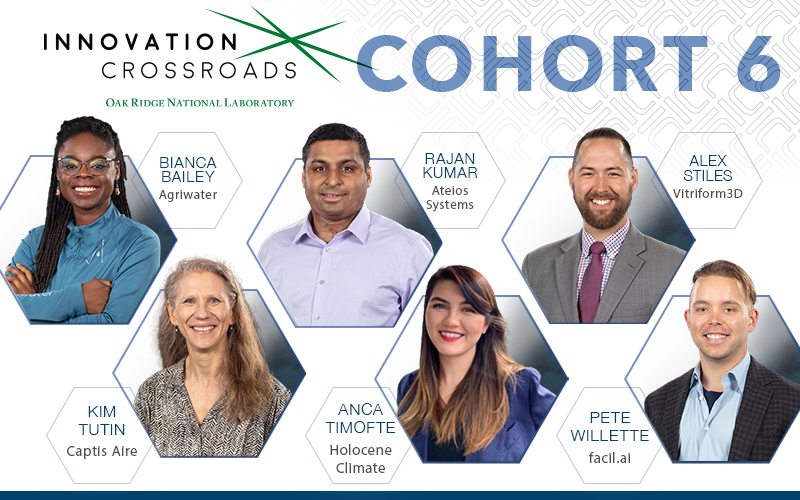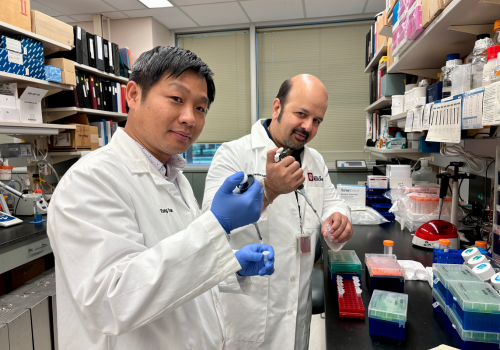DOE’s Advanced Manufacturing Office is sponsoring four innovators this year, with DOE’s Building Technologies Office and the Tennessee Valley Authority each sponsoring one innovator in the Lab-Embedded Entrepreneurship Program. The latest group of scientific entrepreneurs is the first to be onboarded in person and on campus since 2020. Each startup is focused on clean energy technologies.
The innovators were selected through a competitive merit-based process and will have the opportunity to advance technologies they aim to commercialize by working with world-class science experts and unique capabilities at ORNL. These include Frontier, recently named the world’s fastest supercomputer; the Manufacturing Demonstration Facility, DOE’s largest advanced manufacturing research center; the Building Technologies Research and Integration Center, DOE’s only user facility dedicated to buildings research; and the Spallation Neutron Source for atomic-level insight into materials. The innovators will be partnered with a network of mentoring organizations in the Southeast to help develop business strategies to move their technology breakthroughs into the market.
“Through the Lab-Embedded Entrepreneurship Program, we’re empowering entrepreneurs to pursue domestic clean energy innovation and translate ideas into action,” said Kelly Speakes-Backman, DOE’s principal deputy assistant secretary for energy efficiency and renewable energy. “The cutting-edge startups and clean energy technologies that result from this program will reduce greenhouse gas emissions, create good-paying jobs for American workers and strengthen American competitiveness.”
The sixth Innovation Crossroads cohort of fellows and respective projects include:
Bianca Bailey: On-farm water treatment system
Bailey founded Agriwater Corporation to commercialize her dissertation research results. While studying at the University of Illinois, she designed a device called an electro coagulator that purifies livestock wastewater. Her unique system does not require chemical additives typically needed to remove heavy metals and biosolids. The benefits of this technology include helping to reduce expensive farmer discharge fines, creating clean water for irrigation or recycling, and preventing pollution.
Rajan Kumar: Solid-state batteries using rapid heterogeneous deposition of radiation-curable electrodes
Kumar founded Ateios Systems to develop innovative coating and processing technologies necessary to scale solid-state batteries through rapid heterogeneous deposition processes. Ateios uses radiation-curable composite electrodes to increase battery energy density more than 350 watt hours per kilogram and reduce the cost to less than $100 per kilowatt hour. Radiation curable composites will increase manufacturing speeds, reduce processing costs and remove toxic organic solvents from the environment.
Alex Stiles: Large-scale additive manufacturing utilizing recycled glass
Stiles co-founded Vitriform3D Incorporated to utilize inorganic waste materials as recycled feedstocks for new value-added polymeric composite products. Glass is one waste stream with properties that do not degrade when recycled, yet less than one-third of all glass in the U.S. is recycled. This leaves more than 8 million tons of glass going into landfills annually. Vitriform3D has developed a patent-pending binder jet technology to enable large-scale 3D printing of a wide range of recycled powders, starting with pulverized glass.
Anca Timofte: Aqueous organic solvent system for atmospheric decarbonization
Timofte founded Holocene Climate Corporation to design and build chemical plants that efficiently remove carbon dioxide from the atmosphere through novel organic chemistry. Two organic compounds are used cyclically in the process — one compound enhances the capacity of water to take up carbon dioxide, and the other helps remove it from the water through the precipitation of a solid that contains carbon dioxide. When the solid is heated, the carbon dioxide is released in concentrated form and can be stored permanently underground.
Kim Tutin: Advanced air pollution control technology
Tutin established Captis Aire LLC to develop a new advanced air pollution control technology: the fluidized bed concentrator. The system uses specialized bead-activated carbon to adsorb and recover pollutants from the exhaust air rather than oxidize them. Tutin is developing the concentrator for controlling pollutants from wood products produced in manufacturing facilities including those producing liquid biofuels, wood pellets and oriented strand board. In these processes, the primary air pollutant released and recovered is turpentine, which can be sold for a variety of uses. Captis Aire is working to catalytically convert turpentine into sustainable aviation fuel.
Pete Willette: Artificial intelligence-based building control system
Willette co-founded facil.ai Corporation to develop a fully autonomous, end-to-end building control software platform. The technology deploys a virtual closed loop control strategy that leverages grid-interactive efficient buildings control technologies to turn facilities into smart thermal energy storage systems or batteries. The platform also uses proprietary software gateway connectivity and an extreme tagging system for automatic data point discovery and classification.
“We are excited to bring back our Innovation Crossroads cohorts to the ORNL campus over the coming months,” said Susan Hubbard, ORNL’s deputy for science and technology. “These early stage entrepreneurs are developing technologies that will accelerate the decarbonization of the energy, buildings, industry and transportation sectors. They will also support our place-based innovation efforts in the Oak Ridge Corridor and the greater Southeast region.”
Innovators receive a two-year fellowship that provides a cost-of-living stipend, comprehensive business development plan assistance and up to $200,000 toward collaborative research and development at ORNL. Established in May 2017, the program is part of the Lab-Embedded Entrepreneurship Program — created by the Advanced Manufacturing Office within DOE’s Office of Energy Efficiency and Renewable Energy.
“Congratulations to the sixth cohort of innovators selected for Oak Ridge National Laboratory’s Innovation Crossroads program. At TVA, we are working to develop innovative technologies that will help us use electricity in ways that are more renewable and efficient than ever before, and the innovators selected will help in that effort as we work together to help make life better for the people we serve in the Tennessee Valley — and across the country,” said Joe Hoagland, TVA’s vice president of enterprise relations and innovation.
Applications for cohort seven of Innovation Crossroads will open in fall 2022.
DOE’s Office of Energy Efficiency and Renewable Energy accelerates the research, development, demonstration and deployment of technologies and solutions to equitably transition America to net-zero greenhouse gas emissions economy-wide by no later than 2050, and ensure the clean energy economy benefits all Americans, creating good paying jobs for the American people — especially workers and communities impacted by the energy transition and those historically underserved by the energy system and overburdened by pollution.
The Advanced Manufacturing Office catalyzes research, development and adoption of energy-related advanced manufacturing technologies and practices to drive U.S. economic competitiveness and an equitable transition to a decarbonized energy system by 2050.
The Building Technologies Office reduces the energy intensity and related carbon emissions resulting from homes and commercial buildings through the application of cost-effective technologies and practices.
The Tennessee Valley Authority is a corporate agency of the United States that provides electricity for business customers and local power companies serving nearly 10 million people in parts of seven southeastern states. TVA receives no taxpayer funding, deriving virtually all its revenues from sales of electricity. In addition to operating and investing its revenues in its electric system, TVA provides flood control, navigation and land management for the Tennessee River system, and assists local power companies and state and local governments with economic development and job creation.
UT-Battelle manages ORNL for the DOE’s Office of Science, the single largest supporter of basic research in the physical sciences in the United States. The Office of Science is working to address some of the most pressing challenges of our time. For more information, please visit energy.gov/science.




